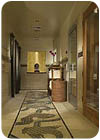
When designing the Catamaran Hotel and Spa in San Diego, CA, Kristine Smith of Kristine Smith Design Studio drew inspiration from Japanese and Asian textile designs, and created a custom porcelain mosaic mural with glass mosaic accents to replicate tropical sea life. The flooring on the men's side of the spa features 1- x 1-inch Tessera glass tiles in a range of natural tones to create a motif of koi fish. Interior Designer: Kristine Smith Design Studio, Valley Center, CA; Architect of Record: Harvey Squire Christensen, Inc.; Design Architect: William M. Hughes; Tile Suppliers: Crossville, Inc., Crossville, TN (porcelain); Oceanside Glasstile, Carlsbad, CA (glass tile); Stone Supplier: Verona Marble Co., Dallas, TX (agglomerate quartz tiles); Installation Material Manufacturer: Custom Building Products, Seal Beach, CA; Stone Fabricator: American Marble, Vista, CA; Tile Installer: California Tile, San Diego, CA

For the women's locker room, 1- x 1-inch Tessera glass tiles were utilized to form an overlapping Japanese fans motif on the floor. According to Smith, she used Oceanside Glasstile's myriad of colors as a “paint palette†to create the hues in the design.
Looking at both ends of the spectrum in terms of size, large-format tiles remain in high demand, but now smaller mosaic pieces and tiny pebbles are being used to create interesting floor, wall and backsplash designs and murals in both the residential and commercial sectors.
From the perspective of color and pattern, glass mosaics continue to be selected for the depth and dimension they bring to a space, while wood and stone-look tiles still gain favor for the natural feel they give to a room. New textures that feel and look like fabrics such as tweed and leather as well as materials formed to replicate wallpaper are also adding variety to designs. Moreover, bright, bold colors, like fiery oranges and reds, are being reveled by designers who are looking to make a statement, and leave their artistic mark on a project.
Connecting a space to the natural environment has also been a recurring theme, as both manufacturers and designers are “bringing the outside indoors†with decorative tiles to resemble natural materials such as sand, grass, asphalt, water, leaves and flowers, among others. Also in this vein, many designers are incorporating tropical design motifs into their projects, often inspired by art forms and textiles of countries with strong cultural traditions such as Asian nations and Japan. Some of theses influences can be seen through landscape murals, natural patterns, and plant and animal replicas, among other applications.
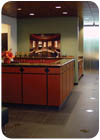
Cawley Architects upgraded the look of its corporate headquarters in Phoenix, AZ, by adding elegant stone materials in exotic, bold colors, such as polished Verde Fire granite from Arizona Tile, which was selected for the reception desktops, credenza back bar and the adjacent coffee bar. In addition, the floor features 16- x 16-inch tiles of honed Montauk Black granite with 6- x 6-inch diamond inlays of Verde Fire granite. Architect: Cawley Architects, Phoenix, AZ; Stone Supplier: Arizona Tile, Phoenix, AZ
Inspired by Cultural Influences
In designing the 9,000-square-foot Catamaran Hotel and Spa in San Diego, CA, Kristine Smith of Kristine Smith Design Studio wanted to maintain the overall existing Hawaiian theme, but step it up a notch. To do so, she looked to inspiration from Japanese and Asian textile designs, and created a custom porcelain mosaic mural with glass mosaic accents to replicate tropical sea life.On the woman's side of the spa, Smith selected 1- x 1-inch Tessera glass tiles from Oceanside Glasstile to form an overlapping Japanese fans motif on the floor. According to the designer, she used the company's myriad of colors as a “paint palette†to create the hues in the design. The flooring in the men's section features the same material, but in a motif of koi fish. For a border on the floor and walls, Smith selected Oceanside Glasstile's Moroccan Desert blend of 1- x 1-inch Tessera iridescent glass tiles.
As a background to the inset mosaics, Legacy, an agglomerated quartz-based material from Verona Marble Co. of Dallas, TX, was selected. The same material can also be found on the countertops and toilet partitions in the restrooms of the spa. “I like using stone on countertops from a practical standpoint,†said Smith. “Granite is too dark and colorful. I wanted something more neutral. The Legacy material is very interesting with beige hues and chips of Mother of Pearl in it.â€
For the perimeter of the space, Smith selected 14- x 28- and 28- x 28-inch porcelain field tiles from Crossville's Empire Series, which she describes as “very creamy.â€

“It is a really rich and unusual looking piece of stone,†said Principal Architect Paul Devers Jr. of Cawley Architcts. “All the reds and greens and metal flecks make it a very dynamic stone.â€
Since a large part of the spa involves wet areas, such as the showers and locker rooms, Smith wanted to utilize a hard, waterproof product like glass tile. “It is a medium I really enjoy working with, and the iridescent quality of it is so natural,†she said.
Although Smith agrees that metallic tiles remain a popular material, she feels that glass tiles have been “incredibly hot†lately. “Everyone seems to be introducing new series of it,†she said. “It has so much depth and dimension to it.â€
Due to the different densities of the ceramic, porcelain and tile materials, and the different substrates and both wet and dry areas, grout color consistency was a major challenge. To avoid unevenness, Alan Rea of California Tile, selected Prismâ„¢ SureColorâ„¢ Grout from Custom Building Products for its formulated lightweight aggregate and its consistent hydration, making it the ideal application for areas that would change humidity levels and temperature.
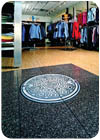
When designing an urban, yet contemporary retail store, Fleet Feet Sports in Hoboken, NJ, the owners selected material from Imagine Tile's Street Smarts line, which includes tile designed to imitate the look of asphalt, crosswalks and manhole covers. At the entryway, they placed 16- x 16-inch tiles resembling asphalt and an LTD manhole cover image, which was formed by using four 16- x 16-inch tiles. Stone Supplier: Imagine Tile, Bloomfield, NJ
Upgrading a Corporate Look
For the remodeling of its 5,600-square-foot corporate headquarters in Phoenix, AZ, employees of Cawley Architects wanted to upgrade the look of their office by adding elegant stone materials in exotic, bold colors. To meet a more contemporary design aesthetic, polished Verde Fire granite from Arizona Tile was selected for the reception desktops, credenza back bar and the adjacent coffee bar.“We knew we wanted to use hard surfaces, so we started with the Verde Fire and worked around those colors,†said Principal Architect Paul Devers Jr. “It is a really rich and unusual looking piece of stone. All the reds and greens and metal flecks make it a very dynamic stone.â€
The flooring throughout the office building features 16- x 16-inch tiles of honed Montauk Black granite with 6- x 6-inch diamond inlays of Verde Fire granite. Additionally, the guest restrooms also feature Verde Fire granite countertops and a Montauk Black granite floor.
Moreover, the floors in the employee coffee bar area and employee restrooms feature 12- x 12-inch tiles of Pearl Green granite, and the same material was also implemented for countertops in both spaces.
“We wanted to carry the stone idea throughout to create richness in the office and to raise the level of design,†said the architect. “The stone countertops add a higher end level to those areas.â€
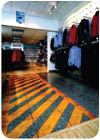
To create the “crosswalk†design that transitions the apparel section of the store to the footwear area, alternating tiles that mimic the look of wood and asphalt were used, while 16- x 16-inch tiles resembling asphalt were utilized on the side of the design.
“Bringing the Outside Inâ€
When designing an urban, yet contemporary retail store, Fleet Feet Sports in Hoboken, NJ, owner Shawn Marlovits and his partner John Fabbro turned to Imagine Tile, which offers an array of unique “outdoorsy†materials, including tiles designed to imitate the look of grass, sand, leaves, rocks, water and asphalt.Since the retail store is largely targeted to runners, the co-owners wanted to bring the look of the streets indoors, and they did so by selecting material from Imagine Tile's Street Smarts line, which includes asphalt, crosswalks and manhole covers.
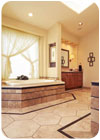
To update the look of a residential bathroom design in Scottsdale, AZ, Jean Claude Canestrelli, ASID Allied Member of Canestrelli Design, selected a variety of shapes and sizes of Castello travertine from Italy, the majority of which are in the form of a hexagon. The floor features a warm taupe-colored Castello travertine from Hexstoneâ„¢ Unique Surfaces of Phoenix, AZ.
Marlovits first stumbled upon the material in Home Depot, and instantly knew it was a look he wanted to implement in his store. After some research, he tracked down Imagine Tile, which is also New Jersey-based, and the project took off from there. The store opened for business in June of 2003, and according to the owner, the reaction has been very positive. “The manhole cover especially catches people's eye,†he said.
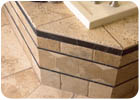
The main floor area consists of 20-inch hexagon tiles in a Monastereâ„¢ finish - which the designer describes as a brushed finish - while the border utilizes 16- x 24-inch tiles. To add contrast to the neutral-toned travertine, black granite mosaic pieces were added to accent areas such as the floor, vanity countertop, tub deck, backsplash and shower. Designer: Canestrelli Design, Scottsdale, AZ; Stone Supplier: Hexstoneâ„¢ Unique Surfaces, Phoenix, AZ
Old World Charm
For the recent design of a residential bathroom design in Scottsdale, AZ, Jean Claude Canestrelli, Allied ASID, of Canestrelli Design, created a unique space using Castello travertine tiles, quarried in Italy. To update the look of the 286-square-foot bathroom, the designer went beyond the use of traditional square and rectangular shapes, and added hexagon-shaped tiles to the space - creating a feel of Old World charm.The floor features warm taupe-colored Castello travertine - supplied by Hexstoneâ„¢ Unique Surfaces of Phoenix, AZ. The main floor area consists of 20-inch hexagon tiles in a Monastereâ„¢ finish - which the designer describes as a brushed finish - while the border utilizes 16- x 24-inch tiles.
While large-format hexagon tiles were used for the floor pattern, the tub facing and shower features bands of smaller 6-inch hexagon travertine tiles, set within a field of small-format, 8-inch-square travertine tiles. “Travertine is a timeless material and has a classic and elegant feeling,†said Canestrelli. To add contrast to the neutral-toned travertine, black granite mosaic pieces were added to accent areas such as the floor, vanity countertop, tub deck, backsplash and shower.

The main powder room of this Manalapan, FL-based residence features a custom “plaid-patterned†marble mosaic in three finishes, including polished Honey Onyx, tumbled Ming Green and honed Blue David. Designer: Marc-Michaels Interior Design, Inc., Winter Park, FL; Stone Suppliers: Mosaico Italiano, Pompano Beach, FL (mosaics); Mizner Industries, Ft. Lauderdale, FL (sink)
Elegance with Mosaics
Melissa Adair of Marc-Michaels Interior Design, Inc. of Winter Park, FL, truly enjoys working with glass tile and mosaics for the visual interest they bring to a space, as well as for the variety of patterns in which they can be used. Adair also likes the idea that the material can be implemented for a wide range of applications, including shower walls, kitchen backsplashes, and in the case of a recently designed Manalapan, FL-based home, as flooring for two powder rooms.The main powder room features a custom “plaid-patterned†marble mosaic in three finishes, including polished Honey Onyx, tumbled Ming Green and honed Blue David - supplied by Mosaico Italiano. “We selected these materials because they were perfect for our color palette, which was a creamy color with gray and soft buttery yellow accents,†said Adair. “The small-scale mosaic went great with the classical interior theme we wanted to create throughout the house.†The designer explained that these materials were also chosen because they complement the custom Crema Maya natural stone pedestal sink, which was supplied by Mizner Industries.
Since the second powder room is off of a clubroom, the designer wanted something darker and moodier. She selected honed Blue David marble because she felt that the “nice rich blue/gray was perfect.†The material was used in 1/2- x 1/4-inch-thick pieces to form a herringbone pattern throughout the 36-square-foot space.
“Our firm typically works with marble, but since we placed 24- x 24-inch squares of marble throughout the house, we felt that the small mosaics served as a nice transition,†said Adair. “It created a nice casual elegance - nothing too formal.â€